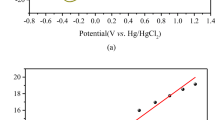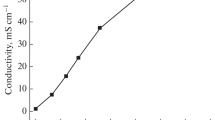Abstract
Although the utilization of deep eutectic solvents (DES) as non-aqueous electrolyte of redox flow batteries has received enormous attention, its properties like high viscosity and low conductivity always remain a matter of concern, due to their negative effect on final battery power performance. Herein, the introduction of two types of additive supporting electrolytes (one: a mixture of dimethyl carbonate (DMC) and ethylene carbonate (EC) and the other: ethyl acetate (EA)) remarkably decreasing the viscosity and impedance of the DES with iron ions is reported, especially for DMC+EC. In addition, the cyclic voltammetry results show that the reversibility of Fe(III)/Fe(II) redox couple, and the reaction kinetics are improved after adding DMC+EC, while EA has little effect on improving the electrochemical performance. From Raman spectroscopy, it is found that a distinct characteristic peak occurs at 895 cm−1 for DMC+EC mixture, whereas the intensity of this peak is weak for EA. It is highly probable that the appearance of this characteristic peak serves to improve the electrochemical properties of DES.

Graphical abstract








Similar content being viewed by others
References
Wu Q, Lv Y, Lin L, Zhang X, Liu Y, Xuelong Z (2019) An improved thin-film electrode for vanadium redox flow batteries enabled by a dual layered structure. J Power Sources 410-411:152–161
Zhang X, Wu Q, Lv Y, Li Y, Zhou X (2019) Binder-free carbon nano-network wrapped carbon felt with optimized heteroatom doping for vanadium redox flow batteries. J Mater Chem A 7:25132–25141
Shahbaz K, Mjalli FS, Hashim MA, AlNashef IM (2011) Using deep eutectic solvents based on methyl triphenyl phosphunium bromide for the removal of glycerol from palm-oil-based biodiesel. Energy Fuel 25:2671–2678
Miller MA, Wainright JS, Savinell RF (2017) Iron electrodeposition in a deep eutectic solvent for flow batteries. J Electrochem Soc 16:4A796–4A803
Wei X, Cosimbescu L, Xu W, Hu JZ, Vijayakumar M, Feng J, Hu MY, Deng X, Xiao J, Liu J, Sprenkle V, Wang W (2015) Towards high-performance nonaqueous redox flow electrolyte via ionic modification of active species. Adv Energy Mater 5:1400678
Wei X, Xu W, Huang J, Zhang L, Walter E, Lawrence C, Vijayakumar M, Henderson WA, Liu T, Cosimbescu L, Li B, Sprenkle V, Wang W (2015) Radical compatibility with nonaqueous electrolytes and its impact on an all-organic redox flow battery. Angew Chem Int Ed 54:8684–8687
Li Z, Weng G, Zou Q, Cong G, Lu YC (2016) A high-energy and low-cost polysulfide/iodide redox flow battery. Nano Energy 30:283–292
Huskinson B, Marshak MP, Suh C, Er S, Gerhardt MR, Galvin CJ, Chen X, Aspuru-Guzik A, Gordon RG, Aziz MJ (2014) A metal-free organic–inorganic aqueous flow battery. Nature 505:195–198
Lin KX, Chen Q, Gerhardt MR, Tong LC, Kim SB, Eisenach L, Valle AW, Hardee D, Gordon RG, Aziz MJ, Marshak MP (2015) Alkaline quinone flow battery. Science 349:1529–1532
Xu Q, Zhao TS (2015) Fundamental models for flow batteries. Prog Energy Combust Sci 49:40–58
Periyapperuma K, Zhang Y, MacFarlane DR, Forsyth M, Pozo-Gonzalo C, Howlett PC (2017) Towards higher energy density redox-flow batteries: imidazolium ionic liquid for Zn electrochemistry in flow environment. ChemElectroChem 4:1051–1058
Osada I, Vries H, Scrosati B, Passerini S (2016) Ionic-liquid-based polymer electrolytes for battery applications. Angew Chem Int Ed 55:500–513
Xu Q, Qin LY, Ji YN, Leung PK, Su HN, Qiao F, Yang WW, Shah AA, Li HM (2019) A deep eutectic solvent (DES) electrolyte-based vanadium-iron redox flow battery enabling higher specific capacity and improved thermal stability. Electrochim Acta 293:426–431
Leung PK, Sanz L, Flox C, Xu Q, Shah AA, Walsh FC (2017) Recent developments in organic redox flow batteries: a critical review. J Power Sources 360:243–282
Xu Q, Ji YN, Qin LY, Leung PK, Shah AA, Li YS, Su HN, Li HM (2018) Effect of carbon dioxide additive on the characteristics of a deep eutectic solvent (DES) electrolyte for non-aqueous redox flow batteries. Chem Phys Lett 708:48–53
Bertilsson S, Larsson F, Furlani M, Albinsson I, Mellander BE (2017) Lithium-ion battery electrolyte emissions analyzed by coupled thermogravimetric/Fourier-transform infrared spectroscopy. J Power Sources 365:446–455
Chen RJ, He ZY, Wu F (2011) Lithium organic borate salt and sulfite functional electrolytes. Prog Chem 23:382–389
Leung PK, Aili D, Xu Q, Rodchanarowan A, Shah AA (2018) Rechargeable organic–air redox flow batteries. Sustain Energy Fuels 2:2252–2259
Zhou HL, Ma XY, Wang YF, Guan XH, Wang B (2012) Transmission performance and free volume of gel electrolyte membranes based on comblike methyl methacrylate copolymers. Acta Chim Sin 70:783–788
Aurbach D, Gamolsky K, Markovsky B, Gofer Y, Schmidt M, Heider U (2002) On the use of vinylene carbonate (VC) as an additive to electrolyte solutions for Li-ion batteries. Electrchim Acta 47:1423–1439
Shu ZX, McMillan RS, Murray JJ, Davidson IJ (1995) Use of chloro chylene carbonate as an electrolyte solvent for a lithium ion battery containing a graphite anode. J Electrochem Soc 142:161–162
He ZZ, Yang MM (2011) Research progress of electrolyte and functional additives for Li-ion batteries. Contemp Chem Indu 40:928–930
Song X, Wu ZS, Yang QQ, Zhou L, Liu JW (2017) Research progress of novel electrolyte additives containing fluorine for lithium ion battery. Chinese J Power Sources 41:1498–1500
Logan ER, Tonita EM, Gering KL, Li J, Ma XW, Beaulieu LY, Dahn JR (2018) A study of the physical properties of Li-ion battery electrolytes containing esters. J Electrochem Soc 165:A21–A30
Dombaycioglu S, Kose H, Aydin AO, Akbulut H (2016) The effect of LiBF4 salt concentration in EC-DMC based electrolyte on the stability of nanostructured LiMn2O4 cathode. Int J Hydrog Energy 41:9893–9900
Guo J, Wen ZY, Wu MF, Jin J, Liu Y (2015) Vinylene carbonate–LiNO3: a hybrid additive in carbonic ester electrolytes for SEI modification on Li metal anode. Electrochem Commun 51:59–63
Dong XL, Guo ZW, Guo ZY, Wang YG, Xia YY (2018) Organic batteries operated at −70°C. Joule 2:902–913
Cao LY, Skyllas-Kazacos M, Menictas C, Noack J (2018) A review of electrolyte additives and impurities in vanadium redox flow batteries. J Energy Chem 27:1269–1291
Kleeman RD (2007) A kinetic theory of gases and liquids. Crastre Press
Abbott AP (2004) Application of hole theory to the viscosity of ionic and molecular liquids. ChemPhysChem 5:1242–1246
Wiercigroch E, Szafraniec E, Czamara K, Pacia MZ, Majzner K, Kochan K, Kaczor A, Baranska M, Malek K (2017) Raman and infrared spectroscopy of carbohydrates: a review. Spectrochim Acta A Mol Biomol Spectrosc 185:317–335
Funding
The work described in this paper was fully supported by National Natural Science Foundation of China (No. 51676092), a grant from the China Postdoctoral Science Foundation (No. 2015M571685, No. 2019M661749), Six-Talent-Peaks Project in Jiangsu Province (2016-XNY-015), High-Tech Research Key Laboratory of Zhenjiang City (No. SS2018002), and the Priority Academic Program Development of Jiangsu Higher Education Institutions (PAPD), China.
Author information
Authors and Affiliations
Corresponding authors
Ethics declarations
Conflict of interest
The authors declare that they have no conflict of interest.
Additional information
Publisher’s note
Springer Nature remains neutral with regard to jurisdictional claims in published maps and institutional affiliations.
Rights and permissions
About this article
Cite this article
Lu, P., Qin, L., Balakrishnan, P. et al. The effect of additive supporting electrolytes on transport and electrochemical properties of deep eutectic solvent (DES) applied in non-aqueous redox flow batteries. Ionics 26, 5029–5036 (2020). https://doi.org/10.1007/s11581-020-03652-z
Received:
Revised:
Accepted:
Published:
Issue Date:
DOI: https://doi.org/10.1007/s11581-020-03652-z




